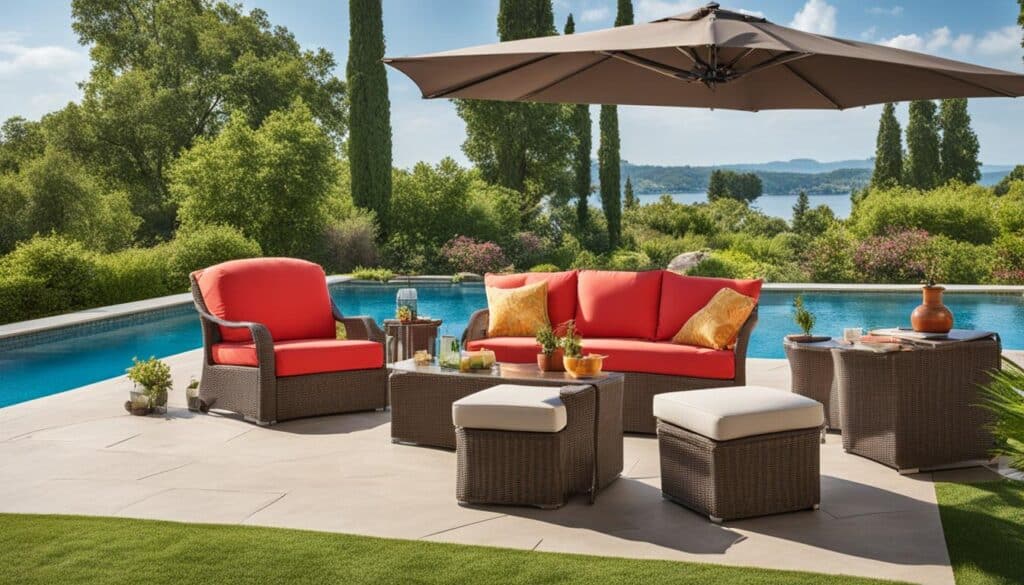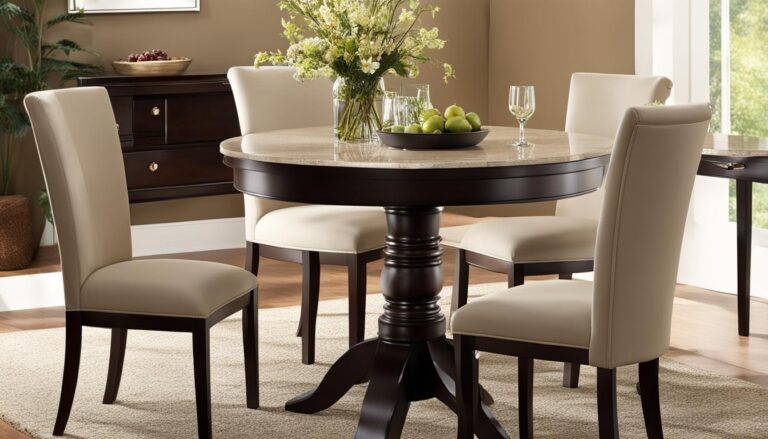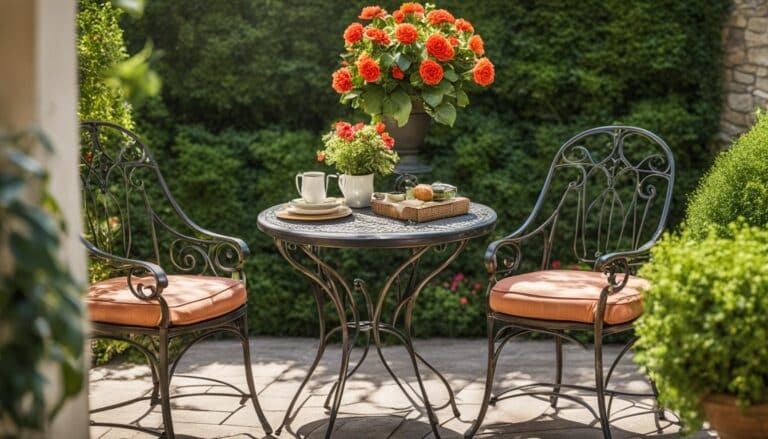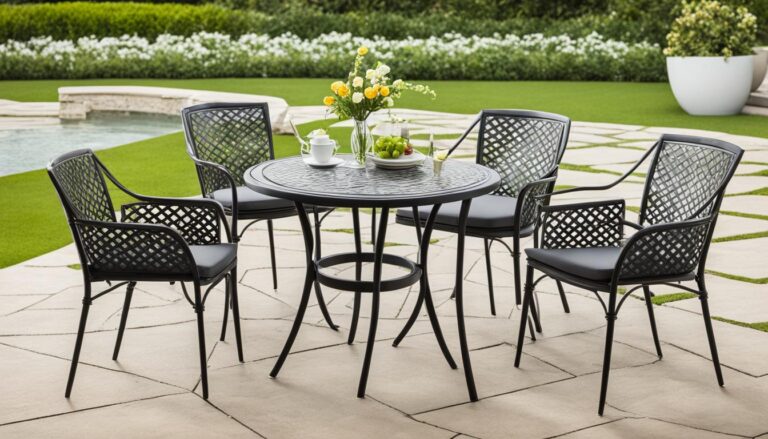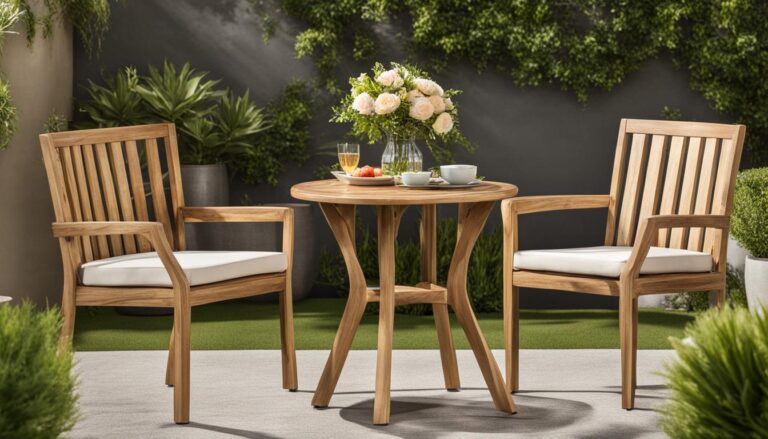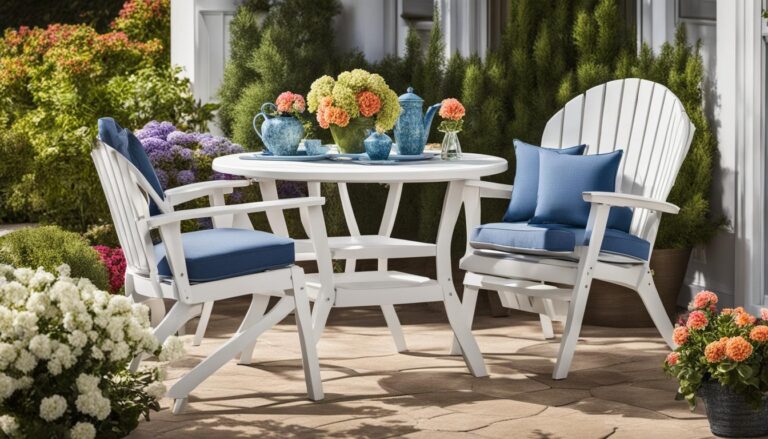Outdoor furniture covers are essential for protecting your patio furniture from the elements. However, windy weather can pose a challenge in keeping these covers in place. Clamps, rocks, and weights can be used to secure the covers, providing additional protection. Cover clamps, in particular, are an affordable and effective solution. By following the proper instructions for using cover clamps, you can ensure that your patio furniture cover stays securely in place, even during strong winds.
Key Takeaways:
- Using cover clamps is an affordable and effective way to keep your patio furniture cover from blowing away.
- Secure the cover with buckle straps and drawcords before using cover clamps.
- Attach bungee cords through the inserts of the clamps to provide additional security.
- Prevent pooling water on your patio furniture cover by using a high-quality air bag.
- When putting on and removing large covers, have someone assist you to make the process easier.
Tips for Using Cover Clamps on Your Outdoor Furniture Cover
When it comes to securing your outdoor furniture cover, cover clamps are a simple and effective solution. These handy devices can help keep your cover in place, even during strong winds. To ensure the best use of cover clamps, follow these tips:
- Start by placing the cover over your furniture and securing any buckle straps or drawcords.
- Unlock the clamp and position it on opposite sides of the cover bottom.
- Make sure that the teeth of the clamp are securely placed over the cover’s hem.
- Attach bungee cords through the inserts of the clamps at the front and rear of your furniture to provide additional security.
By properly using cover clamps, you can prevent your outdoor furniture cover from blowing away and ensure that it stays secure, protecting your furniture from the elements.
Additional Tips for Securing Your Patio Furniture Cover
While cover clamps are a great tool, you can take some extra steps to further secure your patio furniture cover. Consider using patio furniture cover tie downs, which are designed to keep your cover in place during windy conditions. These tie downs can be attached to the corners or sides of your cover and secured to the legs or base of your furniture. This added reinforcement can provide extra peace of mind during storms or gusty weather.
| Benefits of Using Cover Clamps | Benefits of Using Patio Furniture Cover Tie Downs |
|---|---|
| Easy to use | Provide additional reinforcement |
| Affordable and effective | Keep cover in place during storms |
| Secure cover’s hem with teeth | Prevent cover from blowing away |
Whether you choose cover clamps or patio furniture cover tie downs, it’s important to regularly inspect and maintain your outdoor furniture cover to ensure its longevity. By taking proactive measures, you can keep your patio furniture protected and enjoy a worry-free outdoor space.
Preventing Pooling Water on Your Patio Furniture Cover
To ensure the longevity and effectiveness of your patio furniture cover, it is important to prevent pooling water. Pooling water can not only damage the cover but also lead to water leakage and potential damage to your furniture. One effective solution to prevent pooling water is to use a high-quality air bag.
High-Quality Air Bag
A high-quality air bag is designed to fill the low points of your patio furniture cover, creating a slight elevation. This elevation helps promote water runoff, preventing water from accumulating on the cover. By preventing pooling water, you can protect your patio furniture and ensure that your cover remains in good condition.
High-quality air bags are available in different shapes, making it easy to find one that fits your specific patio furniture style. Whether you have a round table, square chairs, or any other shape, there is an air bag that can accommodate your needs. Investing in a high-quality air bag is a simple yet effective way to prevent pooling water and maintain the integrity of your patio furniture cover.
| Air Bag Features | Benefits |
|---|---|
| Durable construction | Ensures long-lasting performance |
| Easy to install | No complicated setup required |
| Waterproof material | Prevents water absorption and damage |
| Multiple size options | Perfect fit for different patio furniture styles |
By incorporating a high-quality air bag into your patio furniture cover setup, you can effectively prevent pooling water and maintain the overall condition of your patio furniture. Additionally, be sure to regularly clean and inspect your cover to ensure its longevity and performance.
Using Air Bags to Prevent Pooling Water
When it comes to protecting your patio furniture cover from pooling water, air bags can be a game-changer. These innovative accessories help promote water runoff, keeping your cover and furniture dry and in excellent condition. Installing air bags is a straightforward process that can provide significant benefits in preventing water accumulation.
Install Air Bags
To install air bags, choose ones that match the shape of your furniture. It’s important to select air bags that are slightly smaller than the furniture itself to ensure a proper fit. Position the air bags in the low points of your cover, such as the center of tabletops or seating areas. If you have larger furniture, you may need to use multiple air bags to cover the entire surface. For easier installation, consider using an air pump to inflate the bags.
Promote Water Runoff
Once the air bags are in place, they will help promote water runoff by elevating the cover’s surface. The elevated areas created by the air bags allow water to flow off the cover instead of pooling. This prevents excess weight from accumulating on the cover and reduces the risk of water seeping through and damaging your furniture. By using air bags to prevent pooling water, you can prolong the lifespan of your patio furniture cover and ensure it remains in optimal condition for longer.
| Air Bag Shape | Recommended Furniture |
|---|---|
| Rectangular | Rectangular tables |
| Circular | Round tables |
| Irregular | Custom or uniquely shaped furniture |
By incorporating air bags into your outdoor furniture protection routine, you can effectively prevent pooling water and ensure the longevity of your patio furniture cover. With their easy installation and ability to promote water runoff, air bags provide a simple yet effective solution to the common problem of water accumulation.
Proper Techniques for Putting on and Removing Large Covers
Putting on and removing large covers can sometimes be a daunting task, but with the right techniques, it can become much easier. Whether you’re protecting your patio furniture or preparing for storage, here are some tips to help you handle large covers with ease.
Putting on Large Covers
When it’s time to put on a large cover, having someone to assist you can make the process much smoother. Follow these steps for a hassle-free experience:
- Roll down the sides of the cover over your furniture, ensuring that it is centered.
- Secure any buckle straps or drawcords to tighten the cover around the furniture.
- Consider using cover clamps to provide extra security and prevent the cover from blowing away.
Removing Large Covers
Removing large covers can be just as easy if you have a helping hand. Here’s how to do it:
- Have someone assist you in carefully rolling the cover off the furniture.
- Clean the cover if necessary, following the manufacturer’s instructions.
- Fold the cover neatly before storing it in a cover storage bag for future use.
By following these proper techniques, you can ensure that putting on and removing large covers becomes a breeze. Whether you’re protecting your outdoor furniture from the elements or getting ready for storage, handling large covers with care will help prolong their lifespan and keep your furniture in good condition.
| Benefits of Proper Techniques for Putting on and Removing Large Covers |
|---|
| Easier and more efficient process |
| Prevention of damage to the cover and furniture |
| Improved preservation of the cover’s lifespan |
| Convenience when storing and retrieving the cover |
Techniques for Storing Your Cover When Not in Use
Properly storing your cover when not in use is crucial for maintaining its quality and extending its lifespan. By following these techniques, you can ensure that your cover remains in good condition for future use.
Step 1: Clean and Dry
Before storing your cover, make sure it is clean and completely dry. Remove any dirt or debris by gently brushing or wiping the cover. Then, allow it to air dry in a well-ventilated area. This will prevent the growth of mold or mildew and keep your cover fresh for the next season.
Step 2: Fold and Store
Once your cover is clean and dry, fold it neatly to minimize wrinkles and creases. Start by folding the cover in half lengthwise, and then fold it again into smaller sections until it is small enough to fit inside a cover storage bag or container. Place the folded cover in the storage bag or container, making sure it is protected from dust, moisture, and pests.
| Storage Option | Pros | Cons |
|---|---|---|
| Cover Storage Bag | – Keeps the cover compact and protected – Easy to carry and store |
– May not provide as much protection against moisture – Requires additional storage space |
| Outdoor Storage Chest | – Offers ample storage space for covers and other items – Provides better protection against moisture and pests |
– Can be bulky and difficult to move – May require additional maintenance |
Step 3: Choose the Right Storage Option
Consider your available space and personal preferences when selecting a storage option for your cover. A cover storage bag is a convenient and portable choice that can be easily stored in a closet or garage. On the other hand, an outdoor storage chest provides larger capacity and better protection against the elements. Choose the option that best suits your needs and ensures the longevity of your cover.
Outdoor Cover Cleaning Tips
Regular cleaning is crucial for maintaining the appearance and functionality of your outdoor furniture covers. By following these tips, you can keep your covers looking their best and ensure they provide optimal protection for your furniture.
Cleaning Methods
When it comes to cleaning your outdoor covers, avoid machine washing or using harsh chemicals as these can damage the fabric. Instead, opt for a gentle hand wash using a mild soap and a garden hose. Gently scrub any stains with a soft-bristled brush. This method is effective in removing dirt and grime without causing any harm to the cover material.
Specialized Cleaners
For stubborn stains or specialized cover materials, such as vinyl or fabric, you can use specific cleaners formulated for these surfaces. Vinyl protective cleaners are effective in removing dirt and enhancing the lifespan of vinyl covers. Fabric cleaners are designed to tackle stains on fabric covers without compromising their integrity. Always follow the manufacturer’s instructions when using these specialized cleaners.
Protective Spray and Guards
In addition to cleaning, you can also apply protective sprays and guards to your outdoor covers. Fabric guards and fabric nanoprotectors create a protective barrier that repels water, stains, and UV rays, keeping your covers in excellent condition. Similarly, vinyl protective sprays offer UV protection and help prevent cracking and fading. Remember to choose the appropriate protector for your cover material and apply it according to the instructions provided.
| Cleaning Method | Benefits |
|---|---|
| Gentle hand wash with mild soap and hose | Safely removes dirt and grime |
| Specialized cleaners (vinyl protective cleaner, fabric cleaner) | Effective in removing stains on specific cover materials |
| Fabric guard, fabric nanoprotector, vinyl protective spray | Creates a protective barrier against water, stains, and UV rays |
Best Practices for Protecting Outdoor Furniture
When it comes to keeping your outdoor furniture safe and secure, there are a few best practices you can follow. By implementing these techniques, you can ensure that your furniture stays in place even during windy conditions.
Invest in Heavy Furniture
One of the most effective ways to prevent outdoor furniture from being blown away is to invest in heavy pieces. Choose furniture made from sturdy materials such as wrought iron, wood, steel, or cast aluminum. These materials provide the necessary weight to resist strong gusts of wind and keep your furniture in place.
Create a Windbreak Wall
Another way to protect your outdoor furniture is to create a windbreak wall. Arrange your furniture in a corner or against a solid wall, which can provide added protection against strong winds. Additionally, you can plant shrubs or install a fence as a windbreak to block out some of the wind and further safeguard your furniture.
Add Weight with Sandbags
If you’re looking for an extra layer of security, consider using sandbags to anchor your furniture. Place sandbags on the base of lightweight chairs or other movable pieces to add weight and stability. This will make it more difficult for the wind to lift or move your furniture, keeping it firmly in place.
| Best Practices for Protecting Outdoor Furniture |
|---|
| Invest in Heavy Furniture |
| Create a Windbreak Wall |
| Add Weight with Sandbags |
Tips for Securing Outdoor Pillows and Cushions
When it comes to keeping your outdoor pillows and cushions secure, there are a few simple techniques you can employ. By storing them properly, using hook and loop strips, or utilizing bungee cords, you can ensure that your pillows and cushions stay in place, even during strong winds.
Storing Outdoor Pillows
One effective method for preventing your outdoor pillows from blowing away is to store them in a deck box. This will keep them safely stored and protected when they are not in use. Alternatively, you can also keep them indoors or in a covered area such as a garage or shed.
Using Hook and Loop Strips
Another strategy is to sew hook and loop strips onto your pillows and cushions and onto your furniture. This will create a strong bond between the pillows/cushions and the furniture, preventing them from being scattered by the wind. Make sure to sew the hook and loop strips securely to ensure maximum effectiveness.
Using Bungee Cords
Bungee cords can also be a great tool for securing your outdoor pillows and cushions. Simply attach one end of the bungee cord to your furniture and the other end to the pillow or cushion, making sure it is tight and secure. This will keep everything in place, even during gusty winds.
| Method | Pros | Cons |
|---|---|---|
| Storing in a deck box | – Provides protection from the elements – Keeps pillows and cushions organized |
– Requires additional storage space |
| Using hook and loop strips | – Creates a strong bond between pillows/cushions and furniture – Easy to remove and reattach |
– Requires sewing onto pillows and cushions |
| Using bungee cords | – Provides a secure hold – Easy to attach and detach |
– May require adjusting tension based on wind conditions |
By employing these tips and techniques, you can ensure that your outdoor pillows and cushions stay in place, no matter how strong the wind may be. Whether you choose to store them in a deck box, use hook and loop strips, or rely on bungee cords, these methods will help protect your outdoor pillows and cushions from being scattered or damaged during high winds.
Anchoring Techniques for Outdoor Furniture
When it comes to keeping your outdoor furniture secure during windy conditions, anchoring techniques can provide the stability you need. By using the right methods, you can prevent your furniture from being blown away and ensure a safe and enjoyable outdoor space. Here are some effective anchoring techniques to consider:
1. Earthquake Glue
Earthquake glue is a strong adhesive that can be used to secure tables, chairs, and other furniture pieces to the ground. Simply apply the glue to the feet or base of the furniture and firmly press it onto the surface. This will create a strong bond that can withstand strong winds. Make sure to follow the manufacturer’s instructions for proper application.
2. Umbrella Base
If you have an umbrella on your outdoor furniture, using a weighted umbrella base can help prevent it from tipping over. Choose a base that is compatible with the size and weight of your umbrella. Secure the base to the ground using bolts or other fasteners to ensure stability. This will keep your umbrella in place even during gusty winds.
3. Sandbags
Sandbags are an affordable and versatile option for anchoring lightweight furniture pieces. Fill sandbags with sand or gravel and place them on the base or legs of the furniture. The weight of the sandbags will keep the furniture grounded. Make sure to distribute the sandbags evenly for optimal stability. Remember to store the sandbags in a dry place to prevent moisture buildup.
By implementing these anchoring techniques, you can prevent your outdoor furniture from being blown away and enjoy a secure and comfortable outdoor space. Choose the method that suits your furniture and weather conditions, and ensure proper installation for best results. With these precautions in place, you can relax and enjoy your outdoor furniture without worrying about strong winds.
Conclusion
Securing your patio furniture and covers in windy conditions is crucial for maintaining their longevity and protecting your outdoor investment. By following the tips and techniques outlined in this article, you can ensure the security of your outdoor furniture and enjoy a worry-free outdoor space.
Using cover clamps is a simple and effective way to keep your patio furniture cover from blowing away. By properly securing the cover with clamps and attaching bungee cords for added security, you can prevent your cover from being displaced during strong winds.
In addition to securing your covers, anchoring your outdoor furniture can provide extra stability. Techniques such as using earthquake glue, umbrella bases, or sandbags can help keep your furniture in place during windy conditions. Choosing heavy furniture and arranging it against a wall or in a corner can also provide added protection.
Remember to properly store your covers when not in use, clean them regularly, and invest in high-quality materials to ensure the security and longevity of your outdoor furniture. By implementing these strategies, you can enjoy your outdoor space with confidence and peace of mind.
FAQ
How can I keep my patio furniture cover from blowing away?
You can use cover clamps, rocks, weights, or bungee cords to secure your patio furniture cover and prevent it from blowing away.
What are cover clamps and how do I use them?
Cover clamps are affordable and effective tools for keeping your outdoor furniture cover in place. To use cover clamps, secure the cover over your furniture, place the clamp on the opposite sides of the cover bottom, and attach bungee cords through the inserts for additional security.
How can I prevent pooling water on my patio furniture cover?
To prevent pooling water, you can use high-quality air bags that fill the low points of your cover and promote water runoff, ensuring that your cover remains in good condition.
How do I install air bags to prevent pooling water?
Choose an air bag that matches the shape of your furniture, place it in the low points of your cover, and use an air pump for easier installation. Multiple air bags can be used if necessary.
What are the proper techniques for putting on and removing large covers?
When putting on large covers, roll down the sides over the furniture, secure buckle straps and tighten drawcords, and consider using cover clamps for extra security. When removing large covers, have someone assist you in carefully rolling the cover off the furniture.
How should I store my cover when not in use?
Clean and dry the cover before folding it and placing it in a cover storage bag. Store the bag in a garage or outdoor storage chest to keep it protected from the elements.
How should I clean my outdoor furniture covers?
Hand wash your covers with mild soap and a garden hose. Use a soft-bristled brush to scrub stains as needed. Avoid machine washing or using harsh chemicals.
How can I protect my outdoor furniture from strong winds?
Investing in heavy furniture made from durable materials, arranging furniture in a corner or against a wall, and planting a windbreak wall with shrubs can help protect your outdoor furniture from strong winds.
How can I secure outdoor pillows and cushions?
You can store them in a deck box, use hooks and loop strips to secure them to your furniture, or use bungee cords to hold them in place.
What anchoring techniques can I use for outdoor furniture?
Techniques such as using earthquake glue, an umbrella base with bolts, or sandbags can help anchor your outdoor furniture and prevent it from being blown away in windy conditions.
How should I secure my outdoor furniture cover and cushions during high winds?
Use cover clamps, anchor your furniture, and properly store your covers to keep them secure during high winds and protect your investment.

